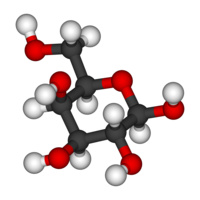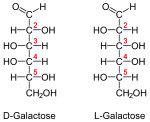Galactose
| Galactose | |
|---|---|
 |
|
 |
 |
| Identifiers | |
| CAS number | 26566-61-0 |
| PubChem | 6036 |
| MeSH | Galactose |
| Properties | |
| Molecular formula | C6H12O6 |
| Molar mass | 180.156 g mol-1 |
| Melting point |
167°C |
| Except where noted otherwise, data are given for materials in their standard state (at 25 °C, 100 kPa) | |
| Infobox references | |
Galactose (Gal) is a type of sugar that is less sweet than glucose. It is considered a nutritive sweetener because it has food energy. Its name comes from the Ancient Greek word for milk, γάλακτος (galaktos). It is an epimer of glucose.
Galactan is a polymer of the sugar galactose. It is found in hemicellulose and can be converted to galactose by hydrolysis. Galactose solubility in water is 68.30 grams per 100 grams of water at 20–25°C.
Contents |
Structure and isomerism
Galactose exists in both open-chain and cyclic form. The open-chain form has a carbonyl at the end of the chain.
Four isomers are cyclic, two of them with a pyranose (six-membered) ring, two with a furanose (five-membered) ring. Galactofuranose occurs in bacteria, fungi and protozoa. [1]

Relationship to lactose
Galactose is a monosaccharide. When combined with glucose, through a dehydration reaction, the result is the disaccharide lactose. The hydrolysis of lactose to glucose and galactose is catalyzed by the enzyme lactase, a β-galactosidase.
In the human body, glucose is changed into galactose via hexoneogenesis in order to enable the mammary glands to secrete lactose. However, most galactose in breast milk is synthesized from galactose taken up from the blood, and only 35±6% is made by de novo synthesis. [2] Glycerol also contributes some to the mammary galactose production. [3]
Galactose and glucose are produced by hydrolysis of lactose by β-galactosidase. This enzyme is produced by the lac operon in Escherichia coli (E. coli).
Sources
It is found in dairy products, sugar beets, and other gums and mucilages.
It is also synthesized by the body, where it forms part of glycolipids and glycoproteins in several tissues.
Clinical significance
Chronic systemic exposure of mice, rats, and Drosophila to D-galactose causes the acceleration of senescence and has been used as an aging model.[4] Two studies have suggested a possible link between galactose in milk and ovarian cancer.[5][6] Other studies show no correlation, even in the presence of defective galactose metabolism.[7][8] More recently, pooled analysis done by the Harvard School of Public Health showed no specific correlation between lactose containing foods and ovarian cancer, and showed statistically insignificant increases in risk for consumption of lactose at ≥30 g/d.[9] More research is necessary to ascertain possible risks.
There are some ongoing studies that suggest that galactose may have a role in treatment of focal segmental glomerulosclerosis (a kidney disease resulting in kidney failure and proteinuria). This effect is likely to be a result of binding of galactose to FSGS factor.
Galactose is a component of the antigens present on blood cells that determine blood type within the ABO blood group system.[10]
Liver galactose metabolism
In the liver, galactose is converted to glucose 6-phosphate in the following reactions:
galacto- uridyl phosphogluco-
kinase transferase mutase
gal --------> gal 1 P ------------------> glc 1 P -----------> glc 6 P
^ \
/ v
UDP-glc UDP-gal
^ /
\___________/
epimerase
Metabolic disorders
There are 3 types of galactosemia or galactose deficiencies:
| Name | Enzyme | Description |
| galactokinase deficiency | Galactokinase | Causes cataracts, which are treatable by restricting galactose from the diet. |
| UDPgalactose-4-epimerase deficiency | UDPgalactose-4-epimerase | Is extremely rare (only 2 reported cases). It causes nerve deafness. |
| Galactose-1-phosphate uridyl transferase deficiency | Galactose-1-phosphate uridyl transferase | Is the most problematic, as galactose-free diets are not effective in treating neurocognitive deficiencies (in particular language disorders such as verbal dyspraxia)and ovarian failure. If a galactose-free diet is administered, cataracts and acute symptoms such as kidney and liver failure respond immediately. |
References
- ↑ Nassau et al. Galactofuranose Biosynthesis in Escherichia coli K-12:... JOURNAL OF BACTERIOLOGY, Feb. 1996, p. 1047–1052
- ↑ Sunehag A, Tigas S, Haymond MW (January 2003). "Contribution of plasma galactose and glucose to milk lactose synthesis during galactose ingestion". J. Clin. Endocrinol. Metab. 88 (1): 225–9. doi:10.1210/jc.2002-020768. PMID 12519857. http://jcem.endojournals.org/cgi/pmidlookup?view=long&pmid=12519857.
- ↑ Sunehag AL, Louie K, Bier JL, Tigas S, Haymond MW (January 2002). "Hexoneogenesis in the human breast during lactation". J. Clin. Endocrinol. Metab. 87 (1): 297–301. doi:10.1210/jc.87.1.297. PMID 11788663. http://jcem.endojournals.org/cgi/pmidlookup?view=long&pmid=11788663.
- ↑ PMID 16710848 (PubMed)
Citation will be completed automatically in a few minutes. Jump the queue or expand by hand - ↑ Cramer D (1989). "Lactase persistence and milk consumption as determinants of ovarian cancer risk". Am J Epidemiol 130 (5): 904–10. PMID 2510499.
- ↑ Cramer D, Harlow B, Willett W, Welch W, Bell D, Scully R, Ng W, Knapp R (1989). "Galactose consumption and metabolism in relation to the risk of ovarian cancer". Lancet 2 (8654): 66–71. doi:10.1016/S0140-6736(89)90313-9. PMID 2567871.
- ↑ Marc T. Goodman , Anna H. Wu , Ko-Hui Tung , Katharine McDuffie , Daniel W. Cramer , Lynne R. Wilkens , Keith Terada , Juergen K. V. Reichardt , and Won G. Ng (2002). "Association of Galactose-1-Phosphate Uridyltransferase Activity and N314D Genotype with the Risk of Ovarian Cancer". Am. J. Epidemiol 156 (8): 693–701. doi:10.1093/aje/kwf104. PMID 12370157.
- ↑ Fung, W. L. Alan, Risch, Harvey, McLaughlin, John, Rosen, Barry, Cole, David, Vesprini, Danny, Narod, Steven A. (2003). "The N314D Polymorphism of Galactose-1-Phosphate Uridyl Transferase Does Not Modify the Risk of Ovarian Cancer". Cancer Epidemiol Biomarkers Prev 12 (7): 678–80. PMID 12869412.
- ↑ Genkinger, Jeanine M., Hunter, David J., Spiegelman, Donna, Anderson, Kristin E., Arslan, Alan, Beeson, W. Lawrence, Buring, Julie E., Fraser, Gary E., Freudenheim, Jo L., Goldbohm, R. Alexandra, Hankinson, Susan E., Jacobs, David R., Jr., Koushik, Anita, Lacey, James V., Jr., Larsson, Susanna C., Leitzmann, Michael, McCullough, Marji L., Miller, Anthony B., Rodriguez, Carmen, Rohan, Thomas E., Schouten, Leo J., Shore, Roy, Smit, Ellen, Wolk, Alicja, Zhang, Shumin M., Smith-Warner, Stephanie A. (2006). "Dairy Products and Ovarian Cancer: A Pooled Analysis of 12 Cohort Studies". Cancer Epidemiol Biomarkers Prev 15 (2): 364–372. doi:10.1158/1055-9965.EPI-05-0484. PMID 16492930.
- ↑ Peter H. Raven & George B. Johnson (1995). Carol J. Mills (ed). ed. Understanding Biology (3rd ed.). WM C. Brown. pp. 203. ISBN 0-697-22213-6.
|
|||||||||||||||||||||||||||||||||||||||||||||